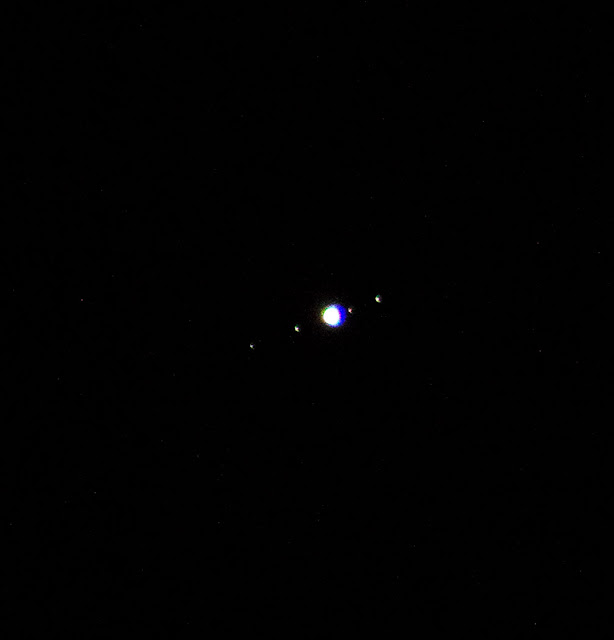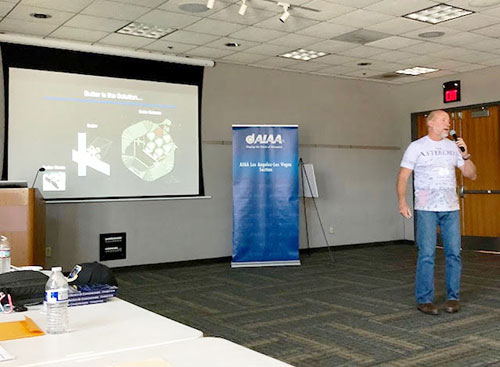Well, the weather prediction finally showed one night without June gloom coming in with clouds. So, we went out to gather some images of Jupiter's Moons' orbital plane to verify the benefits of a polar aligned mount to overcome field rotation.
Most readers, who have tried to do a little imaging of deep sky objects know the benefits of polar alignment to prevent field rotation of the camera, which occurs with Alt/Az mounts, due to the Earth's rotation. My interest in correcting for field rotation occurred again at this time, not because of the benefits to astro-imaging, but just to keep objects like the sun aligned in the camera frame at the same general orientation between images collected at all times of day or night. If a polar aligned mount is not used, the camera field of view would rotate about 15 degrees per hour and you would not be able to compare two images, to monitor the rotation rate of sun spots for example, that were taken several hours apart.
So to verify the benefits of polar alignment, I used the small polar aligned tracking mount, shown below, with attached DSLR wit 300mm lens, which was used to take images of the orbital plane of Jupiter's moons.
 |
| Setup with 300mm DSLR on polar alignment mount (Source: Palmia Observatory) |
So, once the mount was just eyeball aligned with the north celestial pole, the skies were too bright with city lights glow to actually see the North Star, a couple of images of Jupiter were taken. The images were spaced just over two hours apart. I wanted to take images much wider apart but, well, let's just face facts here, I got tired and cold and wanted to go to bed.
This first image was taken just as the skies were getting good and dark at about 9:36 PM, using 1/8 second exposure. Note the orbital plane as identified by the lineup of the four visible moons of Jupiter.
 |
| Starting position of Jupiter's moons orbital plane at 9:36 PM (Source: Palmia Observatory) |
Now, I could have gone off and collected other images during the time the mount was tracking, but I just elected to go back inside and finally go back out at the last possible moment before I went to bed and just took one more image at 11:36 PM. Note that no field rotation is apparent in these two images. If the two images had been taken with an AlT/Az mount, the last image would have shown the moon's orbital plane shifted by about 30 degrees.
So, the next time we get some good solar sunspot activity on the sun, I can take several images of the sun, using this polar aligned mount, and then go back later and analyze and look at the rotation rate of the sun, knowing that the sun is oriented the same in each of the photos. Or at least that is the going forward assumption.
 |
| Ending position of Jupiter's moons orbital plane at 11::55 PM (Source: Palmia Observatory) |
On Saturday, I attended the local AIAA sponsored mini-conference on Planetary Defense, which essentially means how to prevent a possible asteroid strike that could happen in the future. Although the risk of occurrence is very low, the potential damage could be very severe. The conference included talks by half dozen experts who have looked at various aspects of asteroid collisions with the Earth. They described the history of detection of near earth objects and talked about how some of the asteroid orbits come very close to crossing the orbit of the Earth. We know the Earth has been struck multiple times and many of us have seen a small asteroid burn up in the sky with a spectacular fireball. These collisions are mostly harmless, but a large asteroid strike, like the one that created the Chicxulub crater, which is thought to be also the cause of dinosaur extinction about 66 million years ago, is also possible. Several of the speakers talked about how with advanced space technology we could alter the course of the asteroid so it would not impact the Earth or destroy the asteroid before it could cause damage on the surface. There is still much work to be done in that area and not everyone agrees on the right approach. Luckily, there is some good funding to at least scan the skies to identify and track the major asteroids that could potentially be a collision intercept with the Earth.
.
 |
| Dr. Nahum Melamed leads off as the first speak at the AIAA Planetary Defense mini-conference in Redondo Beach |
Philips Groves, IMAX Movie Producer, told us about his new IMAX movie, to be released sometime next year, called Asteroid Impact, which will detail the risk associated with a possible asteroid strike on the Earth, and hopefully generate a lot of awareness about the risk and how the risk can be mitigated by developing new space technologies.
 |
| Producer, Philip Groves, discusses the upcoming IMAX documentary "Asteroid Impact" |
Another speaker, Dr. Joel Sercel, of Transastronautica Corporation, told us of their vision which can be used to mine asteroids and once you have the capacity of mining asteroids you can also use that technology for planetary defense. He described the mining technique which uses sunshine, focused by large inflatable, and hence lightweight mirrors, to ablate away asteroids and capture the volatiles released at that time in another large inflatable bag. He says that the focused energy, large mirrors and gas collecting bags are pretty far along in their development cycle, say around TRL 3-4.
He described the current launch costs associated with typical NASA mindset, where there has been only one customer and there has been no real incentive to lower the cost into space. With the new entrepreneurial models now being used, especially the reusability of launch vehicles and the cost to fail in space, will reduce the cost of getting into space by many factors.
 |
| Dr. Joel Sercel describes Trans Astronautica Corp. vision of how asteroid mining lowers the cost of going out into space |
Joel also talked about one of the main benefits of mining the asteroids which is get materials that can be used as propellants. Delivering propellants from the Earth's surface to orbit is a major cost driver of exploring space, but if the propellants can be mined from asteroids then the cost of being in space and travelling around among the asteroids and the moon environment can be much less. He presented some very interesting cost models, and I hope to get copies of those and examine them a little bit more, which showed that first of all the energy cost of getting something into orbit is actually quite low. The cost of the propellant in a typical Falcon 9 rocket launch is only a couple of hundred thousand dollars. So, it is not the cost of fuel at the surface of the Earth that drives the launch cost up. The collected volatiles can also provide water and oxygen for human consumption in space also.
He mentioned how using propellants derived from asteroids such as breaking up water into hydrogen and oxygen could be used. He also described how water itself can be used in a very effective manner using a concept called "solar thermal propulsion." Now we had heard of "solar electric propulsion: where solar electrical power is used to accelerate and eject a propellant as used in currently available ion drive engines, like those used on the Dawn spacecraft. The benefit of using a solar thermal cycle to heat the propellant rather than an electric cycle is that the efficiency of converting solar energy into electricity is not very efficient when compared to just using solar energy to her and eject a propellant such as water. Current space missions often rely on ion propulsion because there is not yet a ready source of propellant in space, but if asteroid mining gets developed, then these more effective propulsion techniques can be used to push around much larger spacecraft. Pretty neat, so thanks for all the updates, Joel!
Separately, as long as we are talking about new rocket engines, the following chart from Astronomy Magazine shows the liftoff payload capability of some past and current rockets. Note how the SpaceX Falcon Heavy mostly outperforms them all except the now not available Saturn V and the up coming SLS and the BFR. If Elon can finalize the design and production of the BFR, which he plans to use to take astronauts to Mars, it will provide the largest lift capability of any rocket for future space missions.
 |
| Payload summary chart comparing Falcon Rocket versions with other rockets (Source: Astronomy Magazine, August 2018) |
Until next time,
Resident Astronomer George
If you are interested in things astronomical or in astrophysics and cosmology
Check out this blog at www.palmiaobservatory.com

No comments:
Post a Comment